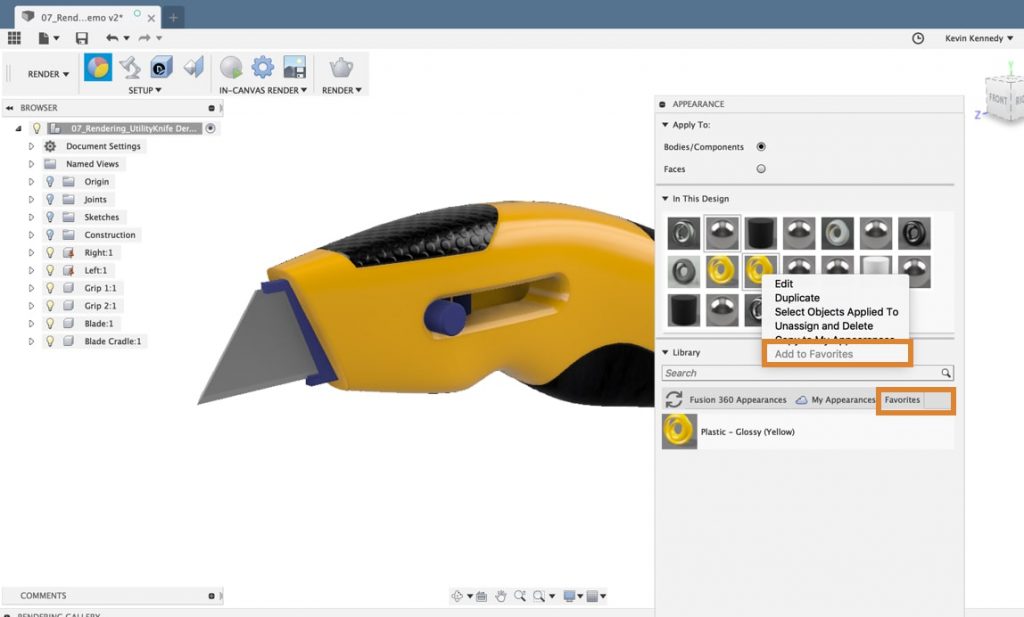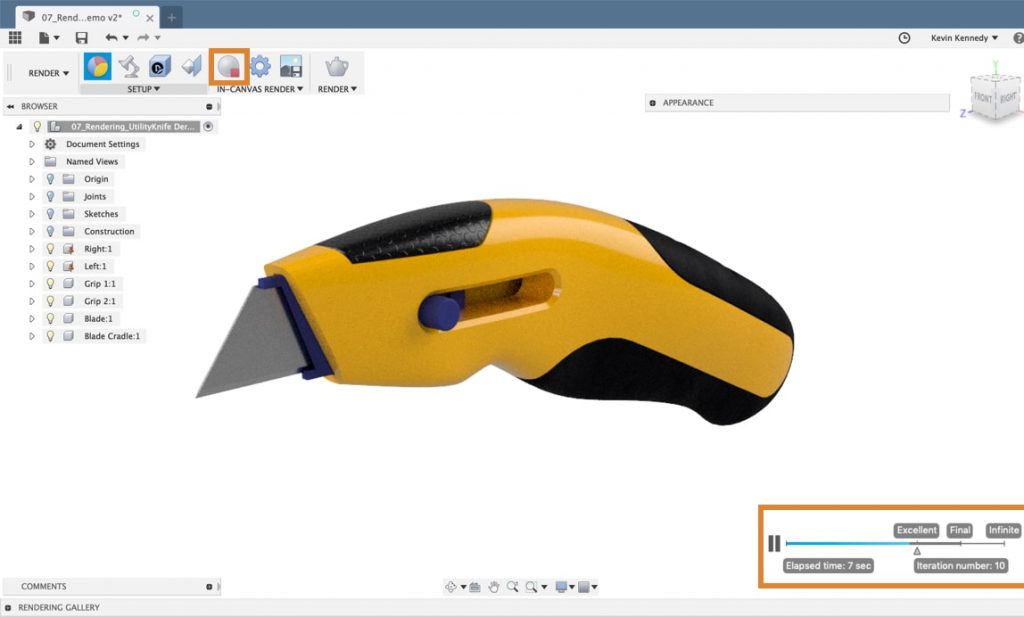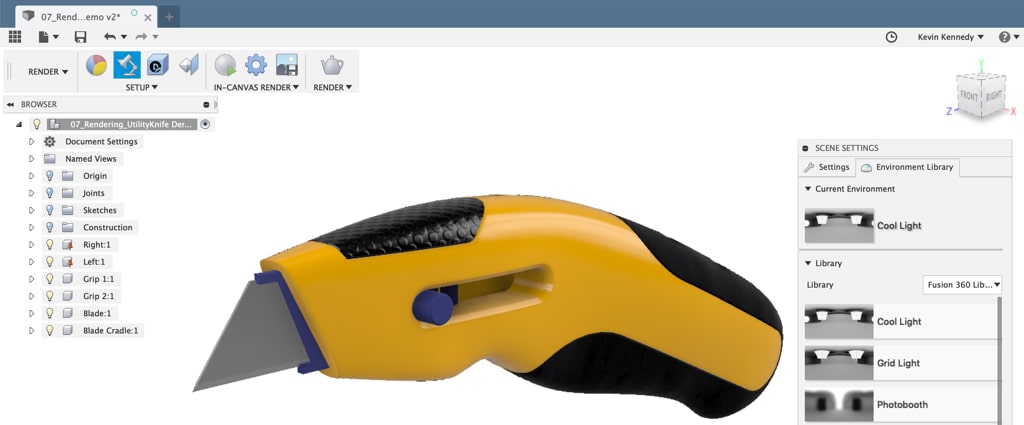Fusion 360 is often commended for its ability to do both CAD and CAM in the same piece of software. Consequently, the Render WorkspaceGenerates realistic renderings of the design. Apply materials, scenery, and lighting. More is often overlooked as a valuable piece of the total picture.
Unlike most of its competitors, Fusion 360 allows users to create photorealistic product renderings within the program itself – deeming 3rd-party software unnecessary.
If you’re ready to create eye-catching photorealistic renderings then be sure to follow these ten favorite tips of mine.
Tip #1 – Set Your Lighting First
This is a tip that will hopefully save(keyboard shortcut CMD/CTRL+S) Saves the file that is currently open. More you a ton of time. Set your scene’s lighting before you start adding materials. Get the lights positioned the way you want, and then you only need to adjust your materials so they fit(keyboard shortcut “f6”) Makes the current file fill the screen. More the light sources.
Adding the lights after the materials result in you spending a lot of time tweaking both to get the scene to work.
Tip #2 – Save Your Favorite Materials

You can save materials as “favorites” which can help you speed up your workflow. This is particularly helpful when you have custom materials that take time to set up. To save a material as a favorite simply right click on the material and selectThe selection mode controls how objects are select when you drag in the canvas. More “add to favorites.”
You’ll find your saved (favorited) materials under the “favorites” tab within your material library. You can always remove favorites if you find your favorites tab getting too cluttered.
Tip #3 – Adding a Backdrop
The render workspace in Fusion 360 lets you choose the background color for your rendering. However, many times a solid background color just doesn’t cut it.
Consider creating a reusable CAD file that includes walls, floors, and other components. Re-use this file any time that you need to create a render that has a backdrop. Having your own pre-made walls will be a huge benefit. You’ll be able to customize the material properties well beyond the native background properties.
Tip #4 – Save Your File Often
Creating an eye-catching render in Fusion 360 can take quite a bit of time. Be sure to save your file often.
Part of creating an awesome product rendering is exploring new perspectives and possibilities with materials and lighting. Consider saving your file each time you create a new perspective or change the lighting around. This will allow you to go back and explore those unique views later on.
Tip #5 – Fillet all of Your Edges
Hold any product in your hand and take a close look atRe-arranges screen to look at selected object. More it. You’ll notice that all edges have a slightly rounded edge, even if they appear to be squared off. Unless of course, your object is a sharp blade or knife, you’ll want to leave the edge without a filletPlaces an arc of a specified radius at the intersection of two lines or arcs. Select the vertex or the two lines or arcs. Specify a radius for the fillet. More.
When we render a product the software will create a small reflection of light which adds another level of detail. This extra reflection helps convince our brain that the object is real.
Tip #6 – Use a Good CAD Model
Using a high-quality CAD model can make all the difference between a fair and a good render. Sometimes you’ll even find it necessary to separate a functional model for manufacturing and a CAD model tweaked specifically for rendering.
A CAD model made specifically for rendering may include details that are altered to look better in the rendering software. Tiny textures, holes, and material thickness are all key factors in making the brain think it’s seeing a real photograph. Remember that hardly any surfaces are perfectly flat. You’ll find that some textures are better added in the CAD file itself versus the rendering materials.
Tip #7 – Avoid Pure Colors
Stay away from colors that are too pure. For example, you’ll never want to apply the color black at the end of the spectrum – RGB (00,00,00). In the real world, black never appears to be completely black because of lights and reflections.
Surfaces that use an absolute black will not reflect any light in the rendering software and will create “black holes.” Lowering the level of black will help the reflections look natural making the black color appear realistic.
This practice can be used for just about every color. Try to stay away from colors at the end of the color palette.
Tip #8 – Update Your Models
Live updating is one great benefit of using Fusion 360s rendering environment over a 3rd-party software. This means you can update your original CAD model and improve areas as you see fit.
It’s hard to consider everything while creating your model. You’ll find that your lighting sources and materials can really change the way your model looks – often times making you recognize areas that could be improved. Don’t be afraid to go back and forth between the Model and Render Workspaces.
Tip #9 – Use In-Canvas Rendering

Unlike some rendering software, Fusion 360 allows you to see a real-time preview of what the render will look like. The best part – you can continue to update the render details.
Click the “In-Canvas Rendering” button in the toolbarUse the Toolbar to select the workspace you want to work in, and the tool you want to use in the workspace selected. More. You’ll see that Fusion 360 will start to process your render. This does use a lot of your computer’s RAM so I wouldn’t recommend doing this all the time. But this feature can be particularly helpful as you practice creating photorealistic renderings.
Tip #10 – Consider Post Processing
Fusion 360’s Render Workspace has come along way the last few years. However, I believe there will always be a need for some good post-processing in a photo editor such as Adobe Photoshop.
Consider doing some post-processing of the photo. You can tweak the lighting, add fine text or other details that would get lost in the render, or add motion blur to change the focal pointCreates a sketch point. More of the render.

Leave a Reply